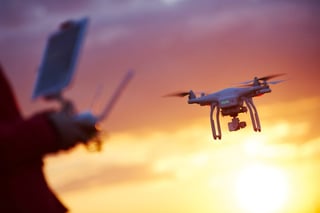REDWOOD LOGIN
Redwood PortalLTL
SCS
SCS Support
Rockfarm


The United States is at the forefront of drone usage and technology. But one controversial holdup—the Remote ID proposal—has essentially halted the growth of the commercial drone industry.
Let’s dive into the usage of commercial drones and take a look at why this Remote ID tracking proposal has become so controversial.
In late 2015, the FAA authorized the use and flight of commercial drones in the United States. Since then, the commercial drone industry has developed rapidly and exponentially. What was once considered a “toy” has become the future of commerce, transport, surveillance, and more. The ability to take to the skies in small, advanced and unmanned robotics has—and will continue to—revolutionize the way almost every industry does business.
Drones might just be the next big thing in the supply chain too!
The possibilities for the use of commercial drones are endless. But there are currently still some restrictions on how drones can be utilized, due to a number of safety and security issues.
First, drones—both recreational and commercial—have to share the highways in the sky with other aircraft. That means drones flying where they shouldn’t, like near airports and large buildings, could cause some problems in terms of potential collision and routing.
Second, there are reasonable concerns about drones flying over people, military bases, or crowded areas (like large sporting events or concerts). Unfortunately, hacked drones could be manned by the wrong people and do some serious damage. These cyber-threats are hard to account for without knowledge of the drone’s operator and purpose. Even a rogue drone without malicious intent could cause injury.
Basically, we need to know where drones are and who’s flying them to ensure they’re not going to cause any damage to people or property.
Remote identification (ID) and tracking would require licenses and license plates for drones. Since drones aren’t manned by an operator in the sky, it’s especially important to be able to have access to the flyer or owner’s information.
This would ensure that the drone is where it should be (not rogue), and that it is being used for effective and safe purposes.
For example, a drone might be flying over a park. A police officer can look up the drone’s identification to see that it’s just a local photographer with a license to take pictures of the park. This ensures he’s not looking to do anything dangerous, and the officer can also check that he has clearance from any nearby airports or military bases to avoid collisions.
Without the passing of a remote identification and tracking regulation, it’s impossible for drones to be utilized at full capacity. Currently, drones can’t:
That creates a lot of restrictions about where and what drones can do. Having remote identification means that drones could move more freely, but there would still be “eyes” on them from everywhere with permitted officials.
Passing a remote ID law would be the building block to other policies and drone operations that could radically improve the industry. Drones could start delivering the last mile to customers in cities, surveying areas, filmmaking, and even helping with search and rescue.
The biggest opponents to the passing of the remote ID believe that it will be too costly, too overbearing, and not scalable for drones at large capacity. They’re also concerned about who will have access to the private information of drone fliers.
Those looking to pass the remote ID proposal are looking for means to make it low-cost, sustainable, and scalable. They’re hoping it will be as unencumbered and streamlined as having a license to drive a motor vehicle on the road. They would work to ensure only police officers, aviation authorities, and public officials have access to these unique identifiers and information.
Read: Is a drone supply chain practical in 2019?
Drone technology is constantly advancing, but government regulations need to catch up for safety and security to avoid impeding the future of drone usage. Until law enforcement and national security are comfortable identifying and tracking unmanned crafts, it’s going to be hard for commercial drones to truly takeoff.
We anticipate that despite some opposition and recommendations by the Aviation Rulemaking Committee, remote ID and tracking requirements will be passed in the coming months. The disagreement and controversy has been going on for many years, but there are a lot of different organizations, associations, businesses, and government officials looking for movement forward. People are starting to get antsy about moving towards an agreement that will streamline drone operations while prioritizing security.
Drones are going to revolutionize a number of industries and sectors, including logistics and transportation. A remote ID and tracking regulation is critical to moving forward with operations and safety.
Stay up to date with everything going on in the logistics world by subscribing to our newsletter! Get industry news delivered right to your inbox, so you’re always in the know.